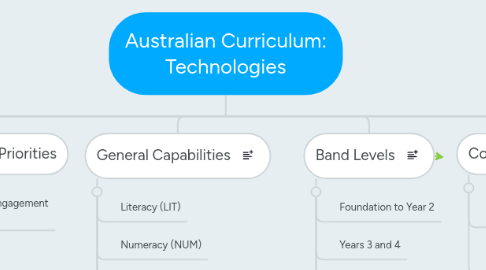Australian Curriculum: Technologies
par Beth platt


1. Aims & Objectives
1.1. Investigate, design, plan, manage, create and evaluate solutions
1.2. Are creative, innovative and enterprising when using traditional, contemporary and emerging technologies, and understand how technologies have developed over time
1.3. Make informed and ethical decisions about the role, impact and use of technologies in the economy, environment and society for a sustainable future
1.4. Engage confidently with and responsibly select and manipulate appropriate technologies − materials, data, systems, components, tools and equipment − when designing and creating solutions
1.5. Critique, analyse and evaluate problems, needs or opportunities to identify and create solutions.
2. Structure
2.1. Digital Technology
2.1.1. Knowledge and Understanding
2.1.1.1. Digital Systems
2.1.1.2. Representing Data
2.1.2. Process and Production Skills
2.1.2.1. Defining
2.1.2.2. Designing
2.1.2.3. Implementing
2.1.2.4. Evaluating
2.1.2.5. Collaborating and Managing
2.2. Design and Technology
2.2.1. Knowledge and Understanding
2.2.1.1. Technologies and Society
2.2.1.2. Technologies contexts
2.2.2. Process and Production Skills
2.2.2.1. Investigating
2.2.2.2. Generating
2.2.2.3. Producing
2.2.2.4. Evaluating
2.2.2.5. Collaborating and Managing
3. Key Concepts
3.1. Abstraction
3.2. Data Collection
3.3. Algorithms
3.4. Specification
3.5. Implementation
3.6. Interaction
3.7. Impacts
3.8. Digital Systems
4. Key Ideas
4.1. Preferred Futures
4.2. Project Management
4.3. Thinking Skills
4.3.1. Design Thinking
4.3.2. Computational Thinking
4.3.3. Systems Thinking
